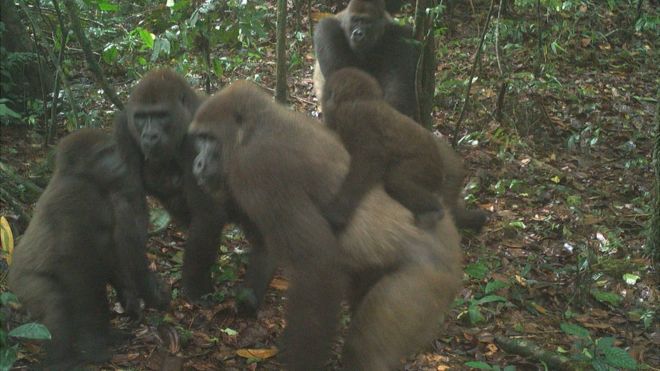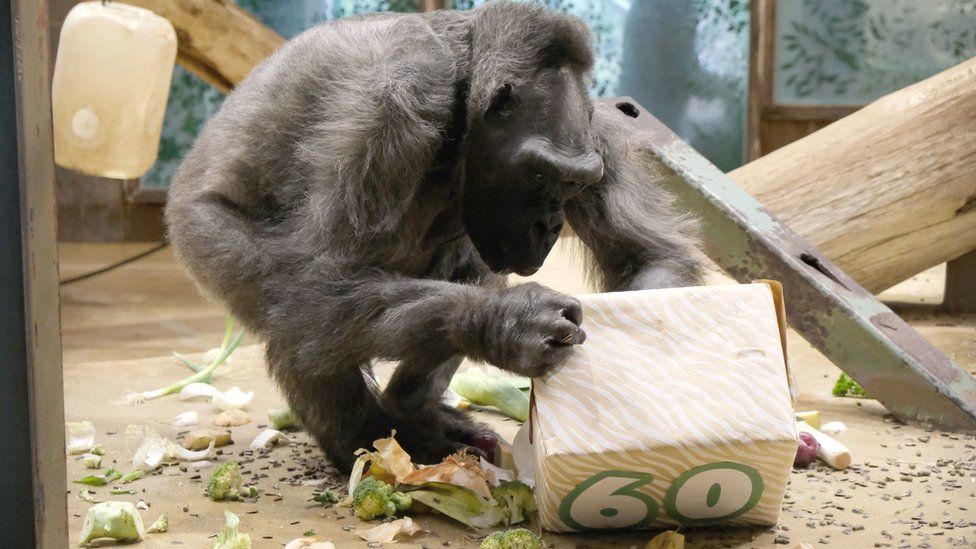Scientists Study Gorilla Who Uses Tools
By ANJAN SUNDARAM, Associated Press Writer
21 minutes ago
GOMA, Congo - An infant gorilla in a Congo sanctuary is smashing palm nuts between two rocks to extract oil, surprising and intriguing scientists who say they have much to learn about what gorillas can do — and about what that says about evolution.
It had been thought that the premeditated use of stones and sticks to accomplish a task like cracking nuts was restricted to humans and the smaller, more agile chimpanzees. Then in late September, keepers at a Dian Fossey Gorilla Fund International sanctuary in this eastern Congo city saw 2 1/2-year-old female gorilla Itebero smashing palm nuts between rocks in the "hammer and anvil" technique, considered among the most complex tool use behaviors.
"This is a surprising finding, given what we know about tool use in gorillas," Dian Fossey Gorilla Fund primatologist Patrick Mehlman said earlier this month at his Goma office.
Mehlman said that the finding indicates that complex tool use may not be a trait developed only by humans and chimpanzees, and could have its origins earlier in the evolutionary chain, among ancestors common to both humans and our closest relatives the great apes.
Gottfried Hohmann, an expert on primates at the Max Planck Institute in Leipzig, Germany, told The Associated Press by phone that Itebero's behavior "means that gorillas have a higher level of understanding of their environment than we thought."
Itebero has been living in the sanctuary for a year, ever since she was confiscated by local authorities from poachers who had been trying to sell her. Mehlman said he believed Itebero, named for a place near where she was found, started cracking nuts spontaneously and had not been influenced by the time she has spent among humans.
Alecia Lilly, a primatologist in Rwanda who worked for over a decade with a colony of captive gorillas in South Carolina and has seen Itebero at work, said most learning among gorillas occurs through imitation. But Itebero had no instructor, alone in her sanctuary with her keeper.
"Itebero is remarkably proficient at cracking nuts," Lilly told The Associated Press by phone. "It takes most chimpanzees many years to reach similar levels of proficiency."
Itebero's actions led some scientists to believe that gorillas in the wild might exhibit complex tool use as well — though no one has ever reported such behavior. Earlier this year, researchers reported observing gorillas in the wild in the neighboring Republic of Congo's rain forests using simple tools, according to a team led by Thomas Breuer of the Wildlife Conservation Society at the Bronx Zoo.
In an e-mail message Monday from the Republic of Congo's Nouabale-Ndoki National Park, Breuer said that in 10 years of observation, his team had seen only two instances of tool use among gorillas — in one a stick was used to test the depth of a pond and in another a small tree trunk was used for support and as a bridge.
Breuer said it was difficult to compare the behaviors his team had seen in the wild with the more complex behavior exhibited by Itebero, who had had contact with humans. But Breuer said Itebero's action "clearly shows that gorillas have the capability to use sophisticated tools even if they do not — or rarely — do this.
"Very often the use of tools is triggered by certain needs and it seems that gorillas have only little needs to use tools in the wild," Breuer said.
In Goma, Mehlman said scientists have not observed gorillas in wild settings for as long as they have chimpanzees.
Breuer said more research was important, but "what we really need to do is to better protect the gorillas and chimps in Central Africa."
"Everybody is excited about such spectacular observations but we should hurry up with our efforts to guarantee them a future," Breuer added. "Certainly many people are impressed by their intelligence and similarities with our own species but there are still a lot of people who eat the apes. We should do everything to stop this.
Scientists estimate that as few as 5,000 Grauer's gorillas, also called eastern lowland gorillas, may remain in the wild, although no comprehensive census of their population has been conducted since the end of Congo's civil war in 2002.
Conflict in Congo saw the decline of many wild species, as thousands of armed groups from Congo, Rwanda and Burundi ran amok in the forests and killed animals for food.
Gorillas Here




